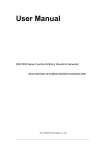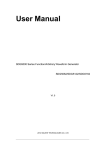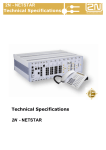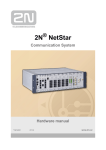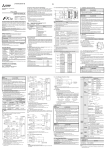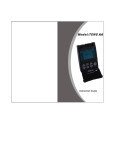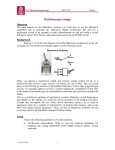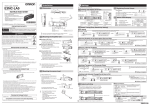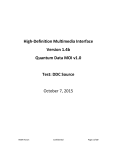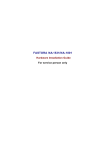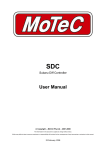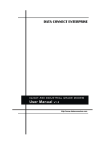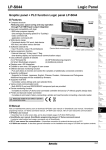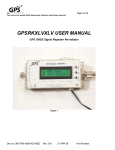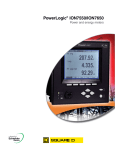Download BeexyBox Type X User Manual
Transcript
BeexyBox Type X User Manual © Beexy - Behavioral Experiment Software Contents 1 2 3 4 Introduction 1 1.1 Rear Panel View . . . . . . . . . . . . . . . . . . . . . . . . . . . . . . . . . . 1 1.2 Accessories . . . . . . . . . . . . . . . . . . . . . . . . . . . . . . . . . . . . . 1 1.3 Handling 2 1.4 Additional Reading . . . . . . . . . . . . . . . . . . . . . . . . . . . . . . . . 2 1.5 Support . . . . . . . . . . . . . . . . . . . . . . . . . . . . . . . . . . . . . . . 2 . . . . . . . . . . . . . . . . . . . . . . . . . . . . . . . . . . . . . . Features 3 2.1 Digital Output Lines . . . . . . . . . . . . . . . . . . . . . . . . . . . . . . . . 3 2.2 Digital Input Lines . . . . . . . . . . . . . . . . . . . . . . . . . . . . . . . . . 3 2.3 Configurable Input/Output Lines . . . . . . . . . . . . . . . . . . . . . . . . 3 2.4 Analog Lines . . . . . . . . . . . . . . . . . . . . . . . . . . . . . . . . . . . . 3 2.5 Tone Generator . . . . . . . . . . . . . . . . . . . . . . . . . . . . . . . . . . . 3 2.6 Timers . . . . . . . . . . . . . . . . . . . . . . . . . . . . . . . . . . . . . . . . 3 2.7 Event Mask . . . . . . . . . . . . . . . . . . . . . . . . . . . . . . . . . . . . . 4 2.8 Input Mask . . . . . . . . . . . . . . . . . . . . . . . . . . . . . . . . . . . . . 4 2.9 Timing . . . . . . . . . . . . . . . . . . . . . . . . . . . . . . . . . . . . . . . . 4 2.10 HID Mode . . . . . . . . . . . . . . . . . . . . . . . . . . . . . . . . . . . . . . 4 2.11 Persistence Settings 5 . . . . . . . . . . . . . . . . . . . . . . . . . . . . . . . Operating Modes 7 3.1 Off Mode And Standby Mode . . . . . . . . . . . . . . . . . . . . . . . . . . . 7 3.2 Input Test Mode . . . . . . . . . . . . . . . . . . . . . . . . . . . . . . . . . . 8 3.3 Voice-key Test Mode . . . . . . . . . . . . . . . . . . . . . . . . . . . . . . . . 8 3.4 HID Test Mode . . . . . . . . . . . . . . . . . . . . . . . . . . . . . . . . . . . 8 3.5 Serve Mode . . . . . . . . . . . . . . . . . . . . . . . . . . . . . . . . . . . . . 8 3.6 HID Mode . . . . . . . . . . . . . . . . . . . . . . . . . . . . . . . . . . . . . . 8 Connections 9 4.1 USB . . . . . . . . . . . . . . . . . . . . . . . . . . . . . . . . . . . . . . . . . 9 4.2 RS-485 . . . . . . . . . . . . . . . . . . . . . . . . . . . . . . . . . . . . . . . . 9 4.3 Power . . . . . . . . . . . . . . . . . . . . . . . . . . . . . . . . . . . . . . . . 9 4.4 Digital Out . . . . . . . . . . . . . . . . . . . . . . . . . . . . . . . . . . . . . 10 4.5 Digital In . . . . . . . . . . . . . . . . . . . . . . . . . . . . . . . . . . . . . . 10 4.6 Configurable In/Out . . . . . . . . . . . . . . . . . . . . . . . . . . . . . . . . 10 i 4.7 5 6 Analog In/Out . . . . . . . . . . . . . . . . . . . . . . . . . . . . . . . . . . . . 10 Jumper Settings 13 5.1 Jumper For Terminating RS-485 Communication Line . . . . . . . . . . . . 13 5.2 Jumper For Supply Voltage on Digital Out Connector . . . . . . . . . . . . 13 5.3 Jumper For Supply Voltage on Digital In Connector . . . . . . . . . . . . . 13 5.4 Jumper For Supply Voltage on Configurable In/Out Connector . . . . . . . 14 Technical Specifications 15 ii The information in this document may contain errors and is subject to change without notice. Document version: 1 Please contact Beexy - Behavioral Experiment Software if you have any questions or comments concerning this document. Website: http://www.beexy.nl E-mail: [email protected] This work is licensed under a Creative Commons Attribution-NonCommercial-NoDerivatives 4.0 International License. ©2015 Beexy - Behavioral Experiment Software iii iv 1 Introduction The BeexyBox Type X is a USB instrument box or input/output box. This device will for example allow you to send out trigger signals to other devices, or to read sensors. It is controlled from a host computer and shares its command set with the BeexyBox Type B response box. Main features are: • USB interface • RS485 interface for controlling up to 31 slave devices • 10 digital outputs (TTL-level) • 10 digital inputs (TTL-level) • 10 configurable input/output lines • 2 analog DC inputs • 2 analog AC inputs • 1 analog AC output • Sub-millisecond synchronization with host computer’s clock The device requires an external power supply to operate (included). 1.1 Rear Panel View On the rear panel (figure 1) there are 8 connectors/sockets. Their purpose are described in detail in §4. The four connectors on the left-hand side are for communication and power supply. The four connectors on the right-hand side provide the digital and analog IO lines. RS−485 USB Power Digital Out Digital In Cfg In/Out Analog In/Out Figure 1: Rear panel 1.2 Accessories Included accessories: • USB-A to USB-B cable 1.8m (optionally 3m) • Power supply 7.5V/800mA • 2x IO cable 1.5m; 14-pin connector to pig tail (custom connector or additional cables on request) BeexyBox Type X User Manual 1 / 16 1.3 Handling • The device is intended for controlling or monitoring other devices in a semi-permanent non-industrial setup. • If water or any other fluid is spilled on the device disconnect it immediately and consult with Beexy support. • Insert dust covers in unused IO connectors. • Before inserting or removing the IO connectors drain off any static charge you may have accumulated. This means touching a ground pad before handling the device. • The device may only be opened to change or check jumpers as described in this manual. Unplug all connectors before opening the case. Make sure to discharge yourself of static electricity. 1.4 Additional Reading • BeexyBox Type B Timing Measurements1 • Bxymonitor User Manual • BeexyBox Programming Manual 1.5 Support If you have any questions about BeexyBox devices please contact Beexy - Behavioral Experiment Software. Website: http://www.beexy.nl E-mail: [email protected] 1 With the exception of the measurements related to the RS-232 interface this document applies to the BeexyBox Type X device as well. 2 / 16 BeexyBox Type X User Manual 2 Features This section describes the features offered by the BeexyBox Type X. 2.1 Digital Output Lines The device provides 10 digital output lines (5V, TTL-level). See connector marked “Digital Out” in figure 1. See also §4.4. These output lines are buffered by a line-driver. Each line has a 330Ω series resistor. This means each line can directly drive a LED. Current drawn from each line should not exceed 8.5mA. The output lines can be controlled by the experiment program. They can be manipulated directly or by timer. 2.2 Digital Input Lines The device provides 10 digital input lines (5V, TTL-level). See connector marked “Digital In” in figure 1. See also §4.5. Each line has a 10kΩ pull-up resistor. This means if desired a push-button can be directly connected between an input line and ground and the device can be used as a response box. 2.3 Configurable Input/Output Lines There are 10 configurable input/output lines (3.3V). See connector marked “Cfg In/Out” in figure 1. See also §4.6. These lines are directly connected to the device’s microprocessor unit. Each line can be configured as a digital input, a digital output or analog input. Seven of these lines can be used for creating capacitive touch sensors.2 And four lines can be used as PWM (pulse width modulation) outputs (which boils down to the lines becoming analog outputs).3 2.4 Analog Lines The device provides 2 analog DC inputs (2.5V), 2 analog AC inputs (2.5Vpeak-to-peak ) and 1 analog AC output (2.5Vpeak-to-peak ). The inputs have 16-bit (effectively 13-bit) resolution and the output has 12-bit resolution. See connector marked “Analog In/Out” in figure 1. See also §4.7. As the analog output is AC coupled it only makes sense to use it for outputting (timed) beeps using the tone generator function. Note, the analog output signal is available on the connector as two separate outputs, but both lines carry the same signal. The device does not perform voice-key function on its analog input(s).4 2.5 Tone Generator The device contains a 10 voice tone generator. Each voice has frequency and waveform type (square, sawtooth, triangle, sine, noise) attributes. The state (on or off) of each voice can be controlled by the experiment program. They can be manipulated directly or by timer. 2.6 Timers The device provides 10 interval timers. They serve no other purpose than to send a time stamped message to the experiment program at predefined times. These timers can be started/stopped by the experiment program. 2 Not yet implemented in BeexyBox firmware 1.0. yet implemented in BeexyBox firmware 1.0. 4 This feature is being considered for firmware V1.1 or later. 3 Not BeexyBox Type X User Manual 3 / 16 2.7 Event Mask To control which events are send to the experiment program running on the host computer the device keeps an event mask. This mask can be set by the experiment program or by using the bxymonitor utility. The following types of events can be enabled/disabled through the event mask: • input events • timer events • clock synchronize request events 2.8 Input Mask By default all digital inputs found on the device are enabled. If it’s desired to (temporarily or semi-permanently) disable one or more inputs you can do so by changing the device’s input mask. This mask can be set by the experiment program or by using the bxymonitor utility. 2.9 Timing Timestamp resolution and precision of the clock in BeexyBox devices is 1μs. Sampling frequency of the digital inputs and outputs is 24kHz5 (41.7μs). Timing accuracy relative to the host computer’s clock depends on the ability to synchronize the device’s clock with the host computer’s clock. We like the standard deviation of the clock synchronization error to stay under 250μs / 3. The most important factor affecting clock sync accuracy is the transmit latency from host computer to device (downstream latency). The measurements presented in BeexyBox Type B Timing Measurements (which applies to the BeexyBox Type X as well) show a latency (systematic error) for USB around 40μs under Linux (and ~80μs under Windows) with standard deviation < 20μs. Once this systematic component has been measured it can be accounted for. The device’s clock and the host computer’s clock will not run at exactly the same pace and both clocks speeds may vary due to temperature changes for example. This is clock drift. The device corrects for any clock drift, provided the experiment program running on the host computer regularly sends a sync-clock command to the device. See the BeexyBox Type B Timing Measurements document or the BeexyBox Programming Manual to learn more. 2.10 HID Mode If desired the device can function as a HID (Human Interface Device). When used as a HID keyboard, mouse or joystick the computer does not talk to the device; it just receives data (key-press events etc.) from the device. These data have to be dealt with as appropriate for keyboard, mouse or joystick input. To associate a digital input action with a particular HID function (keyboard key, mouse button, mouse move, joystick button, etc.) you can use the bxymonitor utility. In HID mode the default associations are: input 0 yields key ’0’, input 1 yields key ’1’, and so on. 5 Changing 4 / 16 the sampling rate to 20kHz or 25kHz is being considered. BeexyBox Type X User Manual 2.11 Persistence Settings The device has many settings that determine its behavior. The settings can be manipulated and saved from your experiment program (or even a custom made program) or more easier, by using the provided bxymonitor utility. Bxymonitor is a command-line application for querying and manipulating settings as well as for trying out and testing the device. The utility allows the user to type in commands for the device to execute. The utility can also perform a number of timing measurements as mentioned in §2.9. BeexyBox Type X User Manual 5 / 16 6 / 16 BeexyBox Type X User Manual 3 Operating Modes The operating modes are the same as for the BeexyBox Type B. However, not all modes are valid or meaningful. The following operating modes are defined: Off Idle Standby Idle Input Test To test digital inputs, digital outputs and analog beep output Voice-key Test N.A. (this mode cannot be entered on the BeexyBox Type X) HID Test To test HID function Serve Device operates as response box HID Device operates as HID Basically only modes Standby and Serve make sense, the other modes are implemented for BeexyBox Type B compatibility. See BeexyBox Type B User Manual. See also diagram in figure 2. Input Test po we Voice−key Test ro HID Test n Standby Off Serve HID Figure 2: BeexyBox Type X operating modes When the device is powered on it enters standby mode as can be seen in the diagram. The dashed arrows in the diagram indicate paths that can only be taken programmatically, that is from an experiment program or using the supplied bxymonitor utility. Button-tapping to trigger a mode switch as for the BeexyBox Type B is not implemented here. Regardless of the operating mode the device always processes commands sent to it by the host computer. 3.1 Off Mode And Standby Mode In these modes the device is idle (waiting for a command to execute). BeexyBox Type X User Manual 7 / 16 3.2 Input Test Mode In the input test mode all inputs, outputs, and tone generator voices can be tested. While pulling down an input a corresponding output should become high and a beep should be played through the analog output. Each input plays a different tone. 3.3 Voice-key Test Mode This mode is not implemented for the BeexyBox Type X.6 3.4 HID Test Mode When in this mode the device converts button press/release actions to HID actions as defined using the bxymonitor utility. For instance, if input 0 maps to key ’a’ then pulling down input 0 will cause the host computer notice that the ’a’ key has been typed. 3.5 Serve Mode In this mode the device sends time stamped events to the experiment program as far as enabled via the event mask (§2.7). Also all bells and whistles the device has to offer can be utilized. To enter this mode the experiment program must send the appropriate mode switch command to the device. At the end of the experiment the experiment program should preferably place the device back to off mode or standby mode. 3.6 HID Mode This mode is similar to the HID test mode. But in addition all bells and whistles the device has to offer can be utilized. In contrast, in HID test mode only the ping and mode switch commands are valid. 6 Voice-key 8 / 16 support is being considered for firmware V1.1 or later. BeexyBox Type X User Manual 4 Connections This section describes the rear panel connections of the BeexyBox Type X. 4.1 USB A USB-B female connector is present for connecting the device via USB to the host computer. All communication runs at 12 Mbit/s (AKA full speed). The device receives power via the USB cable. Some USB ports will yield poorer round-trip latencies then others. Try which ports (c.q. driver) gives the best results. Using a USB hub or extender may also affect round-trip latencies. 4.2 RS-485 A dual 8P8C connector also known as RJ45 connector is present for interconnecting RS-485 compatible devices. RS-485 is a standard that allows creating a multi-point communications network with up to 32 units in a master-slave arrangement. The two provide connectors are wired in parallel. This allows daisy-chaining devices (using regular network cables) while the devices are actually connected in parallel as dictated by RS-485. The RJ45 pinout used is the taken from DMX512, a standard for digital communication networks that are commonly used to control stage lighting and effects. Attention! Do NOT connect the device to a LAN socket. It will not work and may cause harm to the device or to your network equipment. The following figure shows how to connect master and slave devices. Both ends of the chain must be terminated using a 120Ω resistor. For the BeexyBox Type X this is done by placing a jumper (see §...). Master (BeexyBox X) RJ45 white−orange D+ D− GND D+ D− GND 1 orange 2 3 4 5 6 white−brown 7 brown 8 D+ D− GND Rt D+ D− NC NC NC NC GND GND Slave 1 Slave 2 Slave 3 Rt Figure 3: Interconnecting BeexyBox Type X master and slave devices 4.3 Power The power connector is a standard 2.1mm/5.5mm jack. Use a regulated power supply with a voltage between 6.5V and 12V which can deliver at least 250mA. A 7.5V power supply is recommended. BeexyBox Type X User Manual 9 / 16 4.4 Digital Out The pinout of the connector for the digital outputs is as drawn in figure 4. The connector is a 14 pin DIN-41651 header which mates with the flat cable connector mentioned in §1.2. 0 2 4 6 8 Ground 5V 1 3 5 7 9 Figure 4: Digital out connector pinout The signal level on the digital output lines is 5V (TTL level). Each line has a 330Ω series resistor and can directly drive a standard LED. Current drawn should not exceed 8.5mA per line. 4.5 Digital In The pinout of the connector for the digital inputs is as drawn in figure 5. The connector is of the same type as used for digital out (§4.4). 0 2 4 6 8 Ground 5V 1 3 5 7 9 Figure 5: Digital in connector pinout The signal level for the digital input lines is 5V (TTL level). Each line has a 10kΩ pull-up resistor. 4.6 Configurable In/Out The pinout of the connector for the configurable input/output lines is as drawn in figure 6. The connector is of the same type as used for digital out (§4.4). 0 2 4 6 8 Ground 3.3V 1 3 5 7 9 Figure 6: Configurable in/out connector pinout The signal level for these lines is 3.3V. Note, these lines are directly connected to the device’s microprocessor unit, not buffered in any way. To avoid damage due to electrostatic discharge make sure to drain of static charge you’ve accumulated before handling. 4.7 Analog In/Out The pinout of the connector for the analog input/output lines is as drawn in figure 7. The connector is of the same type as used for digital out (§4.4). 10 / 16 BeexyBox Type X User Manual 3.3V Analog in 0 (DC) Analog ground Analog ground Analog in 2 (AC) Analog in 3 (AC) Analog ground Analog in 1 (DC) 3.3V Analog out (AC) Analog out (AC) Analog ground Figure 7: Analog in/out connector pinout There are four groups of three pins each. The maximum signal level for these lines is 2.5V for the DC lines and 2.5Vpeak-to-peak for the AC lines. BeexyBox Type X User Manual 11 / 16 12 / 16 BeexyBox Type X User Manual 5 Jumper Settings The BeexyBox Type X contains four jumpers indicated by the gray rectangles in figure 8. When the jumper marked “TERM” is installed the RS-485 terminator resistor (see figure 3) is in effect. The other three jumpers, from left to right, control feeding power to respectively the digital out connector, the digital in connector and the configurable in/out connector. Before opening the case make sure to drain off any static charge you may have collected and unplug all connectors. TERM 3V3 RS−485 5V 5V DIGITAL OUT DIGITAL IN GP ANALOG Figure 8: Location of jumpers on circuit board 5.1 Jumper For Terminating RS-485 Communication Line To enable/disable the RS-485 line termination place the “TERM” jumper as indicated in the following table. RS-485 terminator resistor jumper installed disabled no enabled (factory default) yes 5.2 Jumper For Supply Voltage on Digital Out Connector To enable/disable feeding the 5V supply voltage to the digital out connector place the jumper above the digital out connector as indicated in the following table. 5V on digital out connector jumper installed disabled (factory default) no enabled yes 5.3 Jumper For Supply Voltage on Digital In Connector To enable/disable feeding the 5V supply voltage to the digital in connector place the jumper above the digital in connector as indicated in the following table. BeexyBox Type X User Manual 13 / 16 5V on digital in connector jumper installed disabled (factory default) no enabled yes 5.4 Jumper For Supply Voltage on Configurable In/Out Connector To enable/disable feeding the 3.3V supply voltage to the configurable in/out connector place the jumper above the configurable in/out connector as indicated in the following table. 3.3V on configurable in/out connector jumper installed disabled (factory default) no enabled yes 14 / 16 BeexyBox Type X User Manual 6 Technical Specifications Case • Flame retardant ABS gray plastic • Dimensions: – width 220mm – depth 140mm – height (excluding feet) 40mm • Anti-slip rubber feet, height 1.5mm Connectivity See figure 1 from left to right: • RS-485 interface: Baud-rate range 1200Bd..115200Bd; Connector dual RJ45; See also §4.2 • USB interface: Fullspeed; Connector USB-B; See also §4.1 • External power: Range 6.5V..12V, recommended 7.5V; Connector 2.1mm/5.5mm jack; See also §4.3 • Digital out: 10 lines, 5V (TTL-level); 330Ω series resistor; Connector 14 pin DIN-41651; See also §4.4 • Digital in: 10 lines, 5V (TTL-level); 10kΩ pull-up resistor; Connector 14 pin DIN-41651; See also §4.5 • Configurable in/out: 10 lines, 3.3V; Connector 14 pin DIN-41651; See also §4.6 • Analog in/out: 2 DC inputs 0..2.5V, 2 AC inputs 2.5Vpeak-to-peak , 1 AC output 2.5Vpeak-to-peak ; Connector 14 pin DIN-41651; See also §4.7 Functions • Digital input • Digital output • 16-bit (eff. 13-bit) analog sensor input • 12-bit analog tone generator output • Response box mode and or HID mode (can operate similar to BeexyBox Type B response box) • 10 voice tone generator • 10 timers • Highly configurable, settings can be made persistent Timing • Timestamp resolution and precision: 1μs • Inputs scanned at 24kHz • In non-HID mode clock is synchronized with host computer’s clock; accuracy better than 250μs, typically less than 50μs, See also BeexyBox Type B Timing Measurements BeexyBox Type X User Manual 15 / 16 Power consumption • 40mA..50mA (excluding connected loads) Accessories Included • USB-A to USB-B cable 1.8m • Power supply 7.5V/800mA • 2x IO flat-cable 1.5m; 14-pin DIN 41651 flat-cable socket to pig tail (unfinished end DIY; custom connector on request) • Utility bxymonitor for setting and querying settings and for determining round-trip latency, clock-drift and clock synchronization accuracy Optional • USB-A to USB-B cable 3m (instead of standard 1.8m) • Additional IO flat-cable 1.5m; 14-pin DIN 41651 flat-cable socket to pig tail (unfinished end DIY; custom connector on request) 16 / 16 BeexyBox Type X User Manual






















